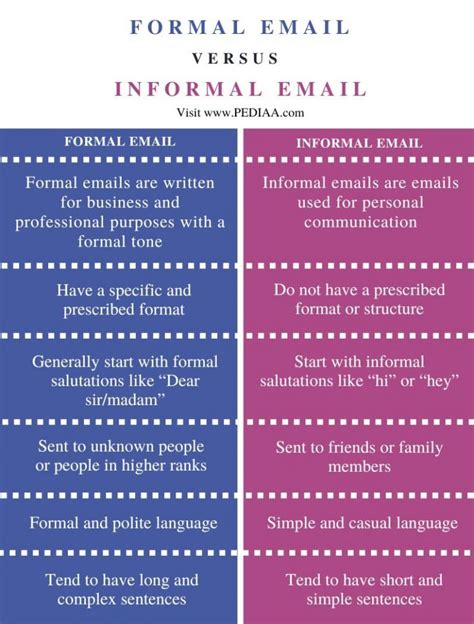

How to Write a Formal Email VS. Informal Email in 2025
Introduction
In the fast-paced world of today’s business landscape, effective communication is paramount. In particular, the ability to craft a well-written formal email can be invaluable in establishing professional relationships, conveying important information, and leaving a lasting impression. However, with the growing prevalence of informal communication channels, it has become increasingly important to understand the distinctions between formal and informal emails and to tailor your writing style accordingly.

What is a Formal Email?
A formal email is one that adheres to a set of conventions and standards commonly accepted in professional settings. These conventions include:
- Formal tone and language
- Proper grammar and punctuation
- Clear and concise writing
- Appropriate use of salutations and sign-offs
- Minimal use of slang or colloquialisms
How to Write a Formal Email
Following these steps can help you write effective formal emails:
1. Start with a Proper Salutation
Begin your email with a formal salutation, such as “Dear Mr./Ms. [Recipient’s Name].” If you are unsure of the recipient’s gender or name, you can use a more general salutation, such as “Dear Hiring Manager” or “Dear Customer Service Team.”
2. Introduce Yourself and State Your Purpose
First, introduce yourself and state the reason for writing the email. For example, “My name is [Your Name] and I am writing to inquire about the open position of [Position Name] that I saw advertised on [Website Name].”
3. Use Clear and Concise Language
Use clear and concise language throughout your email. Avoid using slang or colloquialisms, and make sure that your sentences are easy to understand. Use active voice and strong verbs.
4. Proofread Carefully
Before sending your email, proofread it carefully for any errors in grammar, punctuation, or spelling. You can also ask a colleague to review your email before you send it.
5. Use a Professional Closing
End your email with a professional closing, such as “Sincerely,” “Best regards,” or “Thank you for your time.” You can also include your contact information in your closing, such as your phone number or email address.
6. Use a Formal Font
Use a formal font, such as Times New Roman, Arial, or Calibri. Avoid using fancy or decorative fonts.
7. Use a Standard Font Size
Use a standard font size, such as 12pt or 14pt. Avoid using fonts that are too large or too small.
8. Use White Space
Use white space to make your email more readable. Avoid cramming your text together.
9. Use Bullet Points
Use bullet points to make your email more organized. Avoid using long paragraphs of text.
10. Use Headings
Use headings to make your email more organized. Avoid using all caps or bolding text.
Formal Email Sample
Here is an example of a formal email:
Subject: Application for Marketing Manager Position
Dear [Recipient Name],
I am writing to express my interest in the position of Marketing Manager at [Company Name] as advertised on [Website Name]. With my [Number] years of experience in marketing and my proven track record of success, I am confident that I have the skills and qualifications necessary to excel in this role.
In my previous role as Marketing Manager at [Previous Company Name], I was responsible for [List of Responsibilities]. My achievements in this role include [List of Achievements].
Additionally, I have strong experience in [List of Skills]. I am also a highly motivated and results-oriented individual with a strong work ethic. I am confident that I can make a significant contribution to [Company Name].
I have attached my resume for your review. I am available for an interview at your earliest convenience.
Thank you for your time and consideration.
Sincerely,
[Your Name]
Tips for Writing Formal Emails
Here are some additional tips for writing formal emails:
- Be brief and to the point. Get your message across in as few words as possible.
- Use a professional tone. Avoid using slang or colloquialisms.
- Proofread your email carefully. Make sure there are no errors in grammar, punctuation, or spelling.
- Use proper formatting. Use a standard font size and font style.
- Be respectful. Address the recipient by their proper title.
- Include a call to action. Tell the recipient what you want them to do.
- Follow up. If you don’t hear back from the recipient within a few days, follow up with them.
Benefits of Writing Formal Emails
There are several benefits to writing formal emails, including:
- Convey professionalism: A formal email conveys a sense of professionalism and respect to the recipient.
- Create a good impression: A well-written formal email can create a good impression of you and your company.
- Build relationships: Formal emails can help you build relationships with potential clients, customers, and partners.
- Get results: A formal email can help you get results by persuading the recipient to take a desired action.
Conclusion
In the business world, it’s imperative to know how to write a formal email. A well-written formal email is clear, concise, and professional. It uses formal language and follows the rules of grammar and punctuation. By following the tips in this article, you can write formal emails that will help you build relationships, create a good impression, and get results.










